- Not to be confused with Daedra Lord.
- For other uses, see Daedric Princes (Daggerfall) and Daedric Princes (Collection).
The Daedric Princes (sometimes referred to as Daedra Lords,[1] or the Old Gods by Reachmen) are the most powerful of the Daedra and thus most commonly worshipped by mortals as deities. While Daedra can manifest as either male or female (being, in reality, genderless), all of these high Daedra are typically referred to as "Princes."[2][3] In all, there are sixteen widely known Princes,[4] with a "seventeenth" prince, Jyggalag, emerging following the events of The Elder Scrolls IV: Shivering Isles, at the end of the Third Era.[5]
Every Daedric Prince has their own specific plane of Oblivion, which reflects their nature.[4]
Origins
The Daedric Princes are those et'Ada who, when Lorkhan proposed the creation of Mundus, did not take part but rather created domains out of themselves in Oblivion.[1] There are also accounts of other et'Ada becoming Daedric Princes after the creation of Mundus, which also involves the creation of their own realms of Oblivion.[6]
Mortal interactions
Throughout Tamriel's history, mortals have frequently summoned Daedric Princes, for worship, study or to make deals. These typically involve some sort of bargain with the Prince in question, but not always.[7] It should be noted that dealing with the Princes sometimes causes changes in appearance, such as black dots in the whites of the eyes or strange eye color.[8]
Each Daedric Prince holds some degree of "patronage" over a physical, philosophical, or metaphysical concept or state of being.[9] The varied and wide range of these aspects has nurtured a devoted following among the mortals that hold them as figures of worship- either in spite of or in reaction to the teachings of the Divines. While some of the Princes are unconcerned for the well-being of their followers, with some actively causing harm to them by some means, other Daedric Princes have been known to both reward and actively protect their followers.[10]
Known Daedric Princes
- Azura – A Prince who maintains/draws power from the balance of night and day, light and dark.
- Boethiah – The Prince of deceit, secrecy, conspiracy, treason, and unlawful overthrow of authority.
- Clavicus Vile – The Prince of deals, pacts, power, bargains, and serenity through wish fulfillment.
- Hermaeus Mora – The formless Daedric Prince of knowledge and memory, seeks to possess all that is knowable.
- Hircine – The Prince of the hunt, sport, the Great Game, and the Chase.
- Ithelia – The Prince of paths, the untraveled road, the unseen and fate-changer.
- Jyggalag – The Prince of logical order and deduction, upholds strict order above all else.
- Malacath – The Prince whose sphere is the patronage of the spurned and ostracized.
- Mehrunes Dagon – The Prince of destruction, violent upheaval, energy, and mortal ambition.
- Mephala – The Prince of unknown plots and obfuscation, a master manipulator, a sower of discord.
- Meridia – The Prince of the energies of all living things, enemy of the undead and all who disrupt the flow of life.
- Molag Bal – The Prince of domination and spiritual enslavement, seeks to ensnare souls within his domain.
- Namira – The Prince of the "ancient darkness," the patron of all things considered repulsive.
- Nocturnal – The Prince of the night and darkness, the patron of all things secretive.
- Peryite – The Taskmaster, the Daedric Prince of Pestilence, desires order in his domain.
- Sanguine – The Prince of hedonism, debauchery, and the further indulgences of one's darker nature.
- Sheogorath – The infamous Prince of Madness, whose motives are unknowable.
- Vaermina – The Prince of dreams and nightmares, a deliverer of evil omens and dark portents.
Azura

Statue of Azura in Skyrim.
- Main article: Azura
Azura is the Daedric Prince[10] whose sphere is dusk and dawn.[11] Azura is always depicted as a female and is also known as "Mother of the Rose," "Queen of the Night Sky,"[10] and the Anticipation of Sotha Sil.[12] Her artifact is Azura's Star.[2][3] Azura is one of the few Daedra who might be considered "good" by mortal standards, due to her concern for her followers' well-being. Azura's plane is known as Moonshadow, a realm said to be too beautiful for mortals to comprehend.[4] The lesser Daedra Winged Twilights are her messengers.[13]
It was Azura who told Nerevar that Dagoth Ur's knowledge of the Heart of Lorkhan was accurate.[14] This caused a war with the Dwemer, from which the Chimer emerged the victor, and the Dwemer did not emerge at all. Later, when the Tribunal of Vivec, Almalexia, and Sotha Sil used the power of the Heart of Lorkhan to make themselves gods and thus break their oath to Azura, Azura cursed the Chimer with dark greyish skin and red eyes, transforming them into the Dunmer.[15] and claimed that she would cause Nerevar to be reborn and that she would make things right again.[14] Later, Azura aided the Nerevarine in defeating Dagoth Ur and toppling the Tribunal Temple.[2] Azura is also credited for making the Khajiit from Bosmer stock in Elsweyr.[16]
She is also thought to be the sister of Nocturnal, but whether this is true or not is yet to be known.[10]
Boethiah

Boethiah's Shrine in Oblivion.
- Main article: Boethiah
Boethiah is the Prince of Plots, who rules over deceit, conspiracy, secret plots of murder, assassination, treason, and unlawful overthrow of authority.[9] Boethiah is depicted (often female) as a great caped warrior, typically taking a stoic pose and is also known as the Anticipation of Almalexia.[12] Attribution's Share is the Plane of Boethiah; she frequently holds the Tournament of Ten Bloods in this Plane.[UL 1]
Boethiah is the original god-ancestor of the Dunmer. She guided the Chimer to renounce all ties to the Aldmer and led them, through the prophet Veloth, to the land of Morrowind. She is seen by the Dunmer as the beginning of their civilization and is credited by them as the fount of inspiration for many cultural achievements.[17]
Boethiah is connected to several Daedric artifacts which have appeared on Tamriel throughout history. These include the Ebony Mail,[18] Goldbrand,[19] and Fearstruck.[20]
Clavicus Vile

Clavicus Vile's Shrine in Oblivion.
- Main article: Clavicus Vile
Clavicus Vile is the Daedric Prince whose sphere is the granting of power and wishes through ritual invocations and pacts.[9] Clavicus has a companion named Barbas, who may be a distinct part of Vile while being part of his being.[21] While capable of selective shape-shifting, the form it assumes most of the time is that of a dog, among others.[3] Clavicus himself is depicted as a jovial fellow with horns protruding from his forehead. Clavicus Vile is also noted to be one of the patrons of Cyrodiil's clan of vampires.[22]
Clavicus Vile's realm in Oblivion is called "The Fields of Regret."[23] It appears as an idyllic countryside, dotted with merchant utopias, fields of white clovers, woodland meadows, twisted foliage, and odd melted-looking places. The air smells of both perfume and rotting flesh, while the sky is blue with cottony clouds, and greenish-gray streaks that stain the atmosphere.[24]
Vile has also created many Daedric artifacts, among them the Umbra Sword, the possessed quill Feyfolken and the Masque of Clavicus Vile.[25][18]
Hermaeus Mora
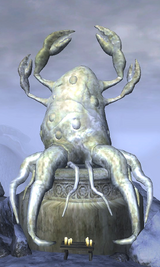
Hermaeus Mora's Shrine in Oblivion.
- Main article: Hermaeus Mora
Hermaeus Mora is the Daedric Prince of knowledge and memory. His sphere is the scrying of the tides of fate, of the past and future as read in the stars and heavens, and in his dominion are the treasures of knowledge and memory.[9] His realm is known as Apocrypha, an endless library where all forbidden knowledge may be found.[4]He may be the "Woodland Man" of Atmoran myth who nearly persuaded the Nords to become Aldmer;[17] the secondary set of his name, Mora, is one word for "wood," "woodland," or "tree(s)" in Aldmeris.[26]
Hermaeus Mora most commonly appears as a rotund mass of tentacles with an abundance of eyes and four disproportionately large lobster-like claws, although he also appears as a grotesque void out of which tentacles appear.[3][27]
His artifacts are all books of one form or another. The most well-known of these, the Oghma Infinium, was written by Xarxes, and contains "knowledge of the ages."[28]
Hircine
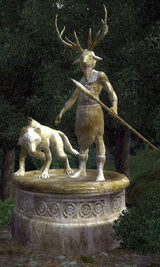
Hircine's Shrine in Oblivion.
- Main article: Hircine
Hircine is the Daedric Prince whose sphere is the Hunt, the Sport of Daedra, the Great Game, and the Chase; he is known as the Huntsman and the Father of Manbeasts.[4] Hircine created the various lycanthropic diseases which transform mortals into beasts, and is, therefore, the father of were-creatures.[29] His plane of Oblivion is known as the Hunting Grounds.[30]
Hircine's statue depicts him as a physically fit man whose whole head is obscured by a deer skull with long antlers. He is armed with a great spear and has a wolf companion.[3] The Reachmen consider that he has five aspects, which relate to a variety of animals and hunters.[31] Hircine communicates directly with were-creatures, and he has been known to give them tasks and rewards. The lesser Daedra Herne is also affiliated with him.[32]
Hircine's artifacts are all associated with hunting or lycanthropy in some way. The Cuirass of the Savior's Hide was allegedly gifted to a mortal after they escaped Hircine's realm,[18] while the Spear of Bitter Mercy is an artifact used in a Daedric hunting ritual,[33] and is seen by the Reachmen as Hircine's own weapon.[31] Hircine's Ring can be used to temporarily bestow lycanthropy on the wearer.[34]
Jyggalag
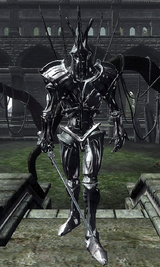
Jyggalag in Shivering Isles.
- Main article: Jyggalag
Jyggalag is the Prince of Order and is one of the more obscure princes.[7] He was cursed by the other Daedric Princes, who were allegedly afraid of him, to become Sheogorath, only returning to his original form during the Greymarch.[35] He is depicted as a crystalline knight.[5]
At the end of the Third Era, with the Greymarch occurring, the Hero of Kvatch defeated Jyggalag, releasing him from his curse, allowing him to remain in his true form and return to Oblivion.[35]
Malacath
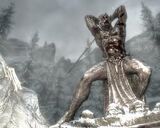
Statue of Malacath in Skyrim.
- Main article: Malacath
Malacath is the Daedric Prince whose sphere is the patronage of the spurned and ostracized, the keeper of the Sworn Oath, and the Bloody Curse.[9] He forms one corner of the House of Troubles in Dunmer religion, as well as being a particular enemy of the Nords.[36][17] Malacath is also called Malouch by Orcs and Orkey or the Old Knocker by Nords, who blame him for stealing mankind's long lifespans.[17] Malacath spurns physical weakness.[36]
He was created when Boethiah ate the Aedra Trinimac, which also transformed his followers into Orcs. Malacath is not recognized as a Daedric Prince by his peers, which fits his sphere perfectly.[37] Some Orcs consider him not to be a Daedra but a demon, instead worshipping Trinimac.[38]
The Ashpit is Malacath's realm and is known as to be a harsh place, consisting only of dust, palaces of smoke, and vaporous creatures.[4]
Malacath's Daedric artifacts tend to be subversions of another artifact or turned against the Daedra themselves. His hammer Volendrung was originally made by the Dwemer,[39] and the Scourge is noted to be particularly effective when used against other Daedra.[40] Some sources also claim that he was the one who forged the Savior's Hide.[41]
Mehrunes Dagon

Shrine of Mehrunes Dagon in Skyrim.
- Main article: Mehrunes Dagon
Mehrunes Dagon is the Daedric Prince of Destruction, Change, Revolution, Energy, and Ambition.[9] He is associated with natural dangers like fire, earthquakes, and floods. He is an especially important deity in Morrowind, where he represents its near-inhospitable terrain and is part of the House of Troubles.[36] In most cultures, however, Dagon is merely a god of bloodshed and betrayal. Dagon's plane of Oblivion is a place of perpetual torture,[42] and is also said to be a blasted landscape.[4] It is known as the Deadlands.
Of all the Daedric Princes, Mehrunes Dagon seems to have the most animosity toward Nirn's species. Given his nature (Prince of Destruction), along with the fact that Daedra truly cannot be destroyed, the only entities he can practice destruction on are mortals. He assisted Jagar Tharn in his temporary usurpation of the Imperial throne by invading and seized control of the Battlespire, the purpose of this being to cripple the capacity of the Imperial College of Battlemages, which presented a threat to Tharn's power as Emperor.[32]
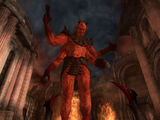
Mehrunes Dagon in Oblivion.
Mehrunes Dagon was responsible for the destruction of Mournhold at the end of the First Era,[43] and apparently also destroyed Ald Sotha, home of House Sotha and Sotha Sil's birthplace.[44]
Dagon invaded Tamriel at the end of the Third Era, precipitating the Oblivion Crisis, where he materialized fully on Tamriel before ultimately being defeated by the Hero of Kvatch and Martin Septim.[3]
Dagon's most celebrated artifact is his Razor, which was said to have been made in Lyg by the Magna Ge.[45] He is also associated with the Daedric Crescents, used by his forces in the invasion of the Battlespire, after which all but one of them were destroyed.[18]
Mephala
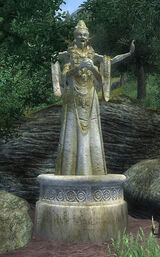
Mephala's Shrine in Oblivion.
- Main article: Mephala
Mephala is a Daedric Prince known by the names Webspinner, Spinner, Spider, and is associated with sex and secret murder by the Dunmer, and is the Anticipation of Vivec.[46][12] Her realm of Oblivion is known as the Spiral Skein.[47]
The Morag Tong is a cult of assassins that was, at least initially, devoted to her worship.[48] She is also associated with the Spider Daedra, although she may not have complete control over them.[13]
Her artifacts share themes of assassination and stealth. She is associated with the Ring of Khajiit,[2] the Obsidian Husk[49] and the Ebony Blade.[50]
Meridia
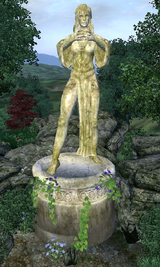
Meridia's Shrine in Oblivion.
- Main article: Meridia
Meridia is associated with the energies of living things, and bears an extremely vitriolic hatred for the undead.[9] Her realm is known as the Colored Rooms.[6] She is associated with a race of lesser Daedra known as Aurorans, and was the patron of Umaril and the Ayleids.[51][52]
Meridia is mentioned in some sources alongside the Star Orphans, and is considered by some to be formerly of the Magna Ge, but created her own realm of Oblivion by bending the light of Magnus through some form of lens.[6] However, there are accounts which question her association with the Magna Ge.[53]
In addition to her hatred of the undead, Meridia also has an enmity for Molag Bal, against whom she acted during the Interregnum, by assisting the Five Companions.[54]
Meridia has been previously associated with the Ring of Khajiit,[55] and gifted her champion with the sword Dawnbreaker in the Fourth Era.[27]
Molag Bal
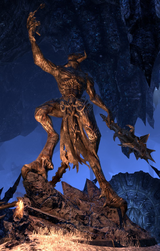
Statue of Molag Bal in Coldharbour.
- Main article: Molag Bal
Molag Bal is the Daedric Prince whose sphere is the domination and enslavement of mortals.[9] His realm is called Coldharbour, a twisted dark imitation of Tamriel.[4] He is associated with many forms of domination, and is known by some as the King of Rape. He forms one corner of the House of Troubles in Dunmeri theology.[36] Just as Meridia hates Bal, he also has an enmity against Boethiah.[2][56]
Molag Bal is reputed to be the father of vampires, who he created by ravaging a priestess of Arkay.[22] He also allegedly fathered a race of monsters with Vivec.[57]
His only known artifact is the Mace of Molag Bal, which is also known as the Vampire's Mace.[18]
Namira
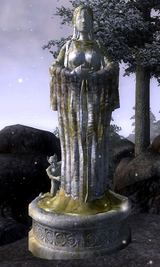
Namira's Shrine in Oblivion.
- Main article: Namira
Namira is the Daedric Prince whose sphere is the ancient darkness.[9] She is associated with all things generally considered repulsive, including various creatures such as spiders or slugs and disease that cause any kind of unattractive physical abnormalities.[58] This also includes beggars and their various attributes.[59] According to Khajiit theology, she has a connection to the Heart of Lorkhaj.[16]
Namira's realm of Oblivion is called the "Scuttling Void." Very little is known about it beyond its name, as no man, mer, nor beast has ever ventured there and returned.[UL 2]
Champions of Namira have been known to receive Namira's ring, an artifact that restores health and stamina when "feasting" on slain enemies.[3][27]
Nocturnal
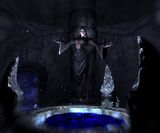
Nocturnal in Skyrim.
- Main article: Nocturnal
Nocturnal is the Daedric Prince whose sphere is the night and darkness, also known as the Night Mistress.[9] She is said to not court worshippers, treating them with indifference,[60] although it also seems that the Nightingales are her sworn servants.[61] In addition to literal darkness, her sphere also encompasses the darkness of mystery and unknowing. She is also on occasion called the sister of Azura.[10]
Her realm of Oblivion is the Evergloam, which has a form of permanent conduit beween Mundus and Oblivion known as the Twilight Sepulcher.[61]
Nocturnal is associated with two artifacts, the Gray Cowl and the Skeleton Key, both of which aid thieves in their work.[18][62]
Peryite
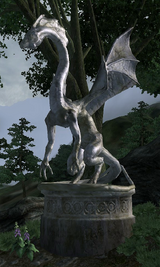
Peryite's Shrine in Oblivion.
- Main article: Peryite
Peryite, also known as the Taskmaster, is the Daedric Prince whose sphere is Pestilence,[7] and he is charged with ordering the lowest levels of Oblivion.[9] He is often depicted as a green dragon.[55]
Peryite's realm of Oblivion is known as "The Pits." It is here in which the lowest orders of Oblivion are guarded. With a few exceptions, the realm is usually unreachable via mortal devices, and due to the lack of accessibility the majority of information regarding this realm is derived from the reports of other Princes.[UL 3]
Peryite's artifact is an enchanted shield, the Spell Breaker,[55] which, protects its bearer against the harmful effects of magic.[18]
Sanguine
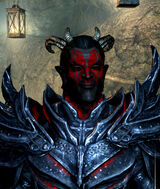
Sanguine in Skyrim.
- Main article: Sanguine
Sanguine is the Daedric Prince whose sphere is hedonistic revelry, debauchery, and passionate indulgences of darker natures.[9]
Sanguine rules over the Myriad Realms of Revelry, which are places that Sanguine allows any visitors to customize to their whims.[63]
Sanguine is associated with the Sanguine Rose, and has bestowed it on favored mortals from time to time.[64][27] He is also associated with a collection of items made for Mephala, known as the Threads of the Webspinner.[65]
Sheogorath
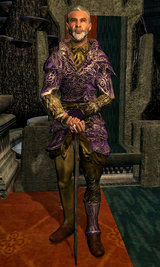
Sheogorath in Shivering Isles.
- Main article: Sheogorath
Sheogorath is the infamous Prince of Madness, whose motives are unknowable.[9] His realm in Oblivion is the Shivering Isles, and he is served by the Golden Saints and Dark Seducers.[66] He forms one of the corners of the House of Troubles in Dunmeri theology.[36] He is frequently depicted as playing tricks on both mortals and other Daedra.[67]
Sheogorath has been called the "Sithis-shaped hole" of the world, created when Lorkhan's heart was torn out.[17] However, other sources indicate he was once Jyggalag, Prince of Order, condemned by the other Daedric Princes to spend most of his existence mad, apart from the time known as the Greymarch where he crusaded against the Shivering Isles.[35] During the late Third Era, the Hero of Kvatch successfully resisted Jyggalag, and the two princes became separate entities.[5]
There are many artifacts associated with Sheogorath, including several staffs, the most notorious being the Wabbajack, which is enchanted to transform or cause death to the caster's target. Others include the Staff of the Everscamp and the Staff of Sheogorath, as well as the glove Gambolpuddy, The Fork of Horripilation, and the lesser known artifact, the Folium Discognitum, a powerful book containing the insights of madmen. He, along with Hircine, the Prince of the Hunt, has an association with the Spear of Bitter Mercy.[68]
Vaermina
- Main article: Vaermina
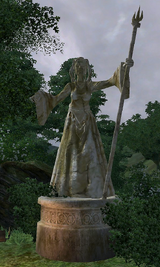
Vaermina's Shrine in Oblivion.
Vaermina is the Daedric Prince whose sphere is the realm of dreams and nightmares, and evil omens.[9] Her plane of Oblivion is Quagmire.[4] It is described as a nightmare realm, where every few minutes reality shifts and becomes ever more horrifying. For example, when lightning strikes that may trigger reality to shift again; it could become anything: a dark castle, a den of terrifying beasts, a moonlit swamp, or even a casket in which one sees oneself buried.[69]
The priests of Vaermina are masters of alchemy. One concoction of theirs can be worth tens of thousands of septims on the black market. Vaermina's Torpor is particularly sought after for its ability to let imbibers enter a state known as "The Dreamstride", allowing them to enter the dreams of another person.[70]
She is associated with the artifact the Skull of Corruption.[55][3][27] She is also associated with an orb, stolen by the wizard Arkved in the late Third Era, which led to her realm.[2]
References
- ↑ 1.0 1.1 The Monomyth
- ↑ 2.0 2.1 2.2 2.3 2.4 2.5 Events of The Elder Scrolls III: Morrowind
- ↑ 3.0 3.1 3.2 3.3 3.4 3.5 3.6 3.7 The Elder Scrolls IV: Oblivion
- ↑ 4.0 4.1 4.2 4.3 4.4 4.5 4.6 4.7 4.8 The Doors of Oblivion
- ↑ 5.0 5.1 5.2 The Elder Scrolls IV: Shivering Isles
- ↑ 6.0 6.1 6.2 Exegesis of Merid-Nunda - Phrastus of Elinhir
- ↑ 7.0 7.1 7.2 On Oblivion
- ↑ The Elder Scrolls V: Dragonborn - dialogue with Neloth
- ↑ 9.00 9.01 9.02 9.03 9.04 9.05 9.06 9.07 9.08 9.09 9.10 9.11 9.12 9.13 The Book of Daedra
- ↑ 10.0 10.1 10.2 10.3 10.4 Invocation of Azura
- ↑ Ancient Tales of the Dwemer, Part XI: Azura and the Box - Marobar Sul
- ↑ 12.0 12.1 12.2 The Anticipations
- ↑ 13.0 13.1 Darkest Darkness
- ↑ 14.0 14.1 Nerevar at Red Mountain - Tribunal Temple
- ↑ The Changed Ones
- ↑ 16.0 16.1 Words of Clan Mother Ahnissi
- ↑ 17.0 17.1 17.2 17.3 17.4 Varieties of Faith in the Empire - Brother Mikhael Karkuxor of the Imperial College
- ↑ 18.0 18.1 18.2 18.3 18.4 18.5 18.6 Tamrielic Lore
- ↑ Events of The Elder Scrolls: Legends
- ↑ The Story of Lyrisius - Bresne Smythe
- ↑ The Vile Truth of Barbas - Pelagius Habor
- ↑ 22.0 22.1 Opusculus Lamae Bal ta Mezzamortie
- ↑ Dialogue with Barbas in The Elder Scrolls Online: Summerset
- ↑ An Elder Scrolls Novel: Lord of Souls - Gregory Keyes
- ↑ Feyfolken II - Waughin Jarth
- ↑ Before the Ages of Man - Aicantar of Shimerene
- ↑ 27.0 27.1 27.2 27.3 27.4 The Elder Scrolls V: Skyrim
- ↑ The Elder Scrolls V: Skyrim - dialogue with Hermaeus Mora
- ↑ An Accounting of Werewolves - Sage Svari of Fallowstone Hall
- ↑ An Accounting of Werewolves - Sage Svari of Fallowstone Hall
- ↑ 31.0 31.1 Aspects of Lord Hircine - Juno Procillus
- ↑ 32.0 32.1 An Elder Scrolls Legend: Battlespire
- ↑ The Posting of the Hunt
- ↑ Events of The Elder Scrolls III: Bloodmoon
- ↑ 35.0 35.1 35.2 The Elder Scrolls IV: Shivering Isles - dialogue with Jyggalag
- ↑ 36.0 36.1 36.2 36.3 36.4 The House of Troubles
- ↑ The True Nature of Orcs
- ↑ Pocket Guide to the Empire, Third Edition: Orsinium — Imperial Geographical Society
- ↑ What is Volendrung? - Gurour
- ↑ The Legendary Scourge
- ↑ Tal Marog Ker's Researches - Tal Marog Ker
- ↑ To All Who Pass Through - Dutheil, Artisan of Oblivion
- ↑ 2920, Sun's Dusk, v11
- ↑ A Brief History of Ald Sotha - Varlinsi Arandu
- ↑ Mythic Dawn Commentaries 4 - Mankar Camoran
- ↑ Vivec and Mephala
- ↑ Rumors of the Spiral Skein - The Derisive Necromite
- ↑ Fire and Darkness
- ↑ The Obsidian Husk
- ↑ With Regards to the Ebony Blade
- ↑ The Song of Pelinal, Book III - On His Enemy
- ↑ Loremaster's Archive: Rituals of the Divines
- ↑ The Library of Dusk: Rare Books
- ↑ Events of The Elder Scrolls Online
- ↑ 55.0 55.1 55.2 55.3 The Elder Scrolls II: Daggerfall
- ↑ Loremaster's Archive: Glorious Upheaval
- ↑ 36 Lessons of Vivec, Sermon 14
- ↑ A Life Barbaric and Brutal - Arthenice Belloq
- ↑ Beggar Prince
- ↑ Hiding with the Shadow
- ↑ 61.0 61.1 The Nightingales, Vol. 1 - Gallus Desidenius
- ↑ Instructions: the Gray Cowl
- ↑ Loremaster's Archive: Maelstrom Arena - Part Two
- ↑ Events of The Elder Scrolls IV: Oblivion
- ↑ The Elder Scrolls III: Morrowind - dialogue with Eno Hlaalu
- ↑ Saints and Seducers - Andoche Marie
- ↑ Sixteen Accords of Madness
- ↑ The Elder Scrolls III: Morrowind - Sheogorath's Quest
- ↑ The Doors of Oblivion — Seif-ij Hidja
- ↑ The Dreamstride
| Daedric Princes | |
|---|---|
| Princes | |
| Related topics | |
